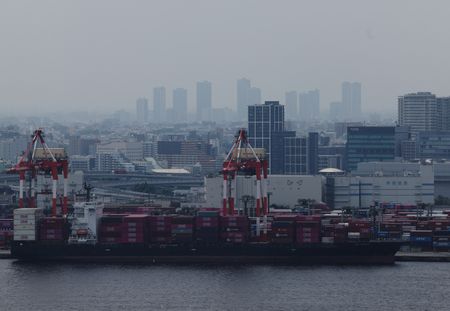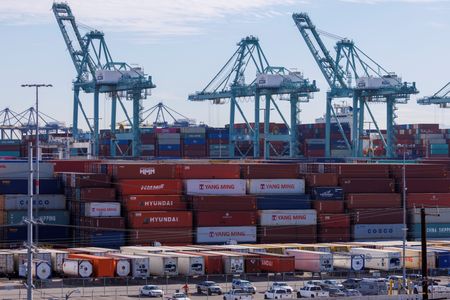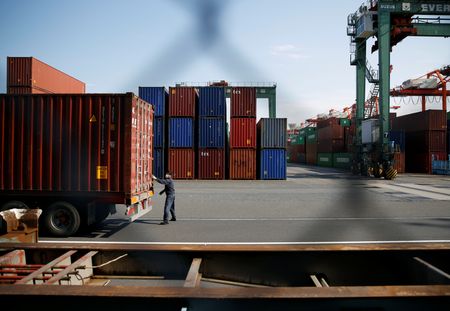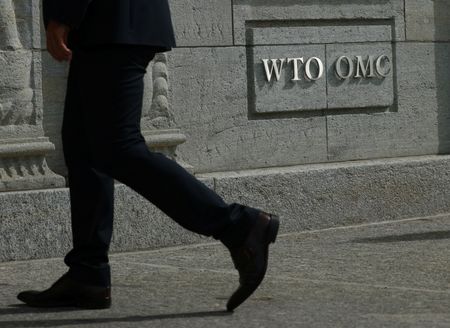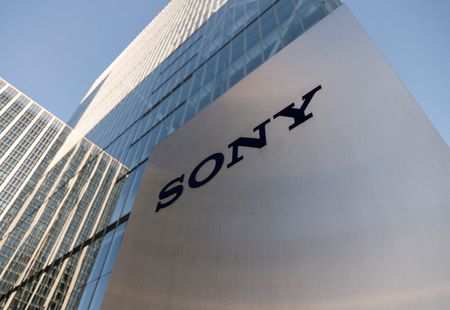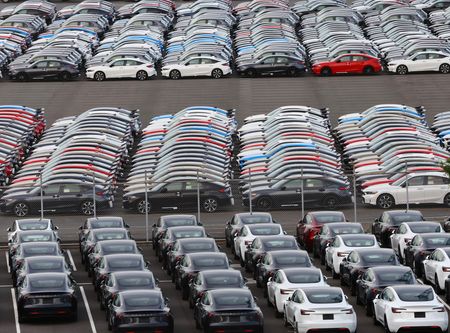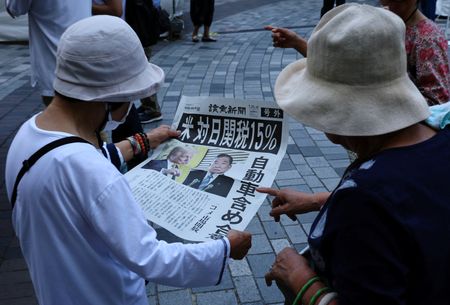(Reuters) -President Donald Trump said the U.S. and Japan have struck a deal that will lower the hefty tariffs Trump had threatened to impose on goods from its Asian ally while extracting commitments for Japan to invest $550 billion in the U.S. and open its markets to American goods.
The agreement – including a 15% tariff on all imported Japanese goods, down from a proposed 25% – is the most significant of the string of trade deals the White House has reached ahead of an approaching August 1 deadline for higher levies to kick in.
COMMENTS
CHRIS WESTON, HEAD OF RESEARCH, PEPPERSTONE GROUP, MELBOURNE:
“Clearly the Japanese equity market likes the deal, and while still scant on details, the move in autos is pronounced and buying activity across the market is picking up and pushing the index closer to 41,000. The 40-year JGB auction will get increased focus, although the issuance size has been taken down and this may be helping the ultra-long end to outperform, with the trade deal causing the 5 & 10-year part of the JGB curve to underperform, with some punchy moves higher in yields.
“Traders are less interested in moving the JPY around, which is surprising given the move in 2-year JGB and the modest uplift in BOJ expectations – but the talk on the floors of a snap election offers some degree of political risk that may be keeping JPY traders sidelined.”
KAZUTAKA MAEDA, ECONOMIST, MEIJI YASUDA RESEARCH INSTITUTE, TOKYO:
“Japan’s success in avoiding the earlier proposed 25% tariff and securing a lower rate for autos is a positive outcome for the Japanese economy. This deal reduces the risk of a recession. However, the timing of the agreement is politically unfortunate. Had Prime Minister Shigeru Ishiba finalised the deal before Sunday’s upper house election, it might have bolstered his party’s performance.”
PRASHANT NEWNAHA, SENIOR ASIA-PACIFIC RATES STRATEGIST, TD SECURITIES, SINGAPORE:
“Markets are greeting the news of a U.S.-Japan trade deal as a positive surprise given first the LDP losing its upper house majority was seen as delaying trade negotiations and second the 15% tariff headline is below the 24%-25% levels Trump threatened in April and earlier this month. One fly in the ointment with this trade deal could be Trump’s demand for Japan to open its borders to U.S. agricultural imports. This could face significant political hurdles for its implementation and further destabilise Japan’s already fragile political landscape.”
RICHARD KAYE, PORTFOLIO MANAGER, COMGEST, TOKYO:
“Japan’s exporters had already adjusted to tariffs – average export prices to the U.S. dropped 18% last month. So, the effect of a deal is perhaps not as big as it might seem.
“Ishiba is probably thrown a lifeline by the deal, following his loss of governing majority in last Sunday’s election. A key point to watch will be rice imports: given the political sensitivity, it is conceivable that Japan waited till Sunday’s election to agree anything here; but flexibility on rice imports would vastly ease Japan’s rice shortage, which has become a major source of inflation.
MA TIEYING, SENIOR ECONOMIST, DBS, SINGAPORE:
“The deal helps reduce tariff-related uncertainty for Asia’s second-largest economy. The 15% tariff may also serve as a benchmark for other North Asian economies, such as South Korea and Taiwan, in their own trade negotiations with the U.S.
“That said, it remains uncertain whether the agreement will meaningfully lift Ishiba’s domestic approval. Inflation and rising living costs — not tariffs — were the main drivers behind the LDP’s losses in Sunday’s upper house election. While the removal of tariff uncertainty should help ease concerns about 2H growth outlook, lingering political and fiscal uncertainty will likely keep the BOJ cautious on rate hikes.”
SHANE OLIVER, CHIEF ECONOMIST & HEAD OF INVESTMENT STRATEGY, AMP, SYDNEY:
“It’s a good sign that deals are being made ahead of even higher rates threatened from August 1. That said, the rates so far (15% on Japan and 19-20% on several Asian countries) are way up on levels at the start of the year and levels where most assumed they would settle.
“The deals are providing some boost to market sentiment on the ground that worst-case tariff rates have been avoided, but share markets have already rallied sharply to new highs in many cases… So, a lot of good news is already factored in.”
SHOTARO MORI, SENIOR ECONOMIST, SBI SHINSEI BANK, TOKYO:
“As Bank of Japan Governor Kazuo Ueda had previously indicated expectations of tariffs exceeding 10%, the 15% rate falls within the BOJ’s anticipated range. Now that the rate is finalised, attention will turn to economic data to be released from August onward, particularly Q2 GDP and corporate earnings. If corporate earnings for April–June are not too weak, the BOJ could move to raise interest rates as early as in October.”
CAROL KONG, CURRENCY STRATEGIST, COMMONWEALTH BANK OF AUSTRALIA, SYDNEY:
“The deal – which sets a much lower tariff rate on Japanese imports including autos – looks to be a positive outcome for Japan. The brief and small lift in the JPY may suggest a US-Japan trade deal was somewhat in the price before the announcement. Concerns about higher Japanese government spending and borrowing also continue to keep downward pressure on the JPY. The 40-year JGB auction later today may be the next source of volatility for the JPY.”
CHRISTOPHER WONG, CURRENCY STRATEGIST, OCBC BANK, SINGAPORE:
“There was some knee-jerk reaction to the trade deal, but largely the moves have stabilised with the dollar/yen trading near its 10- or 11-day low. With tariff uncertainty out of the way for Japan, we keep our eyes peeled on two risks going forward for the dollar/yen – political risks if Ishiba still holds on and if there are any changes to credit rating, dependent on the country’s fiscal health.”
CHARU CHANANA, CHIEF INVESTMENT STRATEGIST, SAXO, SINGAPORE:
“Expectations for a breakthrough were low, so Trump’s announcement delivers a mild upside surprise — providing near-term relief for Japanese equities. The reduced 15% tariff, down from the previously flagged 25%, is meaningful and should lift sentiment in export-driven sectors, even if the fine print, especially on autos, remains critical. Markets will largely discount the $550 billion FDI headline as political theatre rather than a tradable catalyst.
“Strategically, the deal allows Japan to sidestep immediate tariff escalation, while Trump’s attention shifts elsewhere.”
KRISTINA CLIFTON, SENIOR ECONOMIST, COMMONWEALTH BANK OF AUSTRALIA, SYDNEY:
“We don’t know all the details yet, apart from just that he will place a 15% tariff on imports from Japan.
“It’s a lower rate than what President Trump announced on Liberation Day, so to that end, it’s a better outcome than potentially they could’ve seen. Steel, aluminium, and also cars are important exports for Japan, so it’ll be interesting to see if there’s any specific carve-outs for those.”
HIROFUMI SUZUKI, CHIEF CURRENCY STRATEGIST, SMBC, TOKYO:
“This is good news for the Japanese economy.
“There are reports that automobiles will also be subject to a 15% tariff, which is clearly good news. I don’t think this alone will lead to a Bank of Japan rate hike next week, but the possibility of a rate hike between September and October has increased. This will create pressure to buy the yen.”
(Reporting by Reuters Asia bureaus; Compiled and edited by Subhranshu Sahu)

